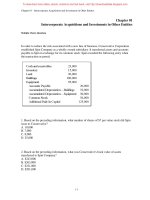CBA financial accounting updateds
Bạn đang xem bản rút gọn của tài liệu. Xem và tải ngay bản đầy đủ của tài liệu tại đây (654.53 KB, 233 trang )
SIMULATION AND ITS DISCONTENTS
Sherry Turkle
WITH ADDITIONAL ESSAYS BY
William J. Clancey,
Stefan Helmreich,
Yanni A. Loukissas,
and Natasha Myers
foreword by John Maeda
DESIGN, TECHNOLOGY, BUSINESS, LIFE
SIMULATION AND ITS DISCONTENTS
SIMPLICITY: DESIGN, TECHNOLOGY, BUSINESS, LIFE
John Maeda, Editor
The Laws of Simplicity, John Maeda, 2006
The Plenitude: Creativity, Innovation, and Making Stu=, Rich Gold, 2007
Simulation and Its Discontents, Sherry Turkle, 2009
S I MULATION A N D ITS DISCONT E N T S
SHERRY TURKLE
With additional essays by
William J. Clancey, Stefan Helmreich, Yanni A. Loukissas,
and Natasha Myers
The MIT Press
Cambridge, Massachusetts
London, England
© 2009 Massachusetts Institute of Technology
All rights reserved. No part of this book may be reproduced in any form by any
electronic or mechanical means (including photocopying, recording, or information storage and retrieval) without permission in writing from the publisher.
For information about special quantity discounts, please email special_sales@
mitpress.mit.edu.
This book was set in Scala and Scala Sans by Graphic Composition, Inc., Bogart,
Georgia. Printed and bound in the United States of America.
Library of Congress Cataloging-in-Publication Data
Simulation and its discontents / Sherry Turkle ; with additional essays by William J.
Clancey . . . [et al.]. ; foreword by John Maeda
p. cm. — (Simplicity—design, technology, business, life)
Includes bibliographical references and index.
ISBN 978-0-262-01270-6 (hbk. : alk. paper)
1. Computer simulation. 2. Visualization. 3. Technology—History. 4. Technology—
Social aspects. I. Turkle, Sherry.
QA76.9.C65T87 2009
003Ј.3—dc22
2008035982
10
9
8
7
6
5
4
3
2
1
To David Riesman and Donald Schön,
Two mentors, two friends
CONTENTS
Foreword by John Maeda
ix
Preface and Acknowledgments
xi
SIMULATION AND ITS DISCONTENTS
Sherry Turkle
1
ø
WHAT DOES SIMULATION WANT?
ø
THE VIEW FROM THE 1980s
ø
DESIGN AND SCIENCE AT THE MILLENNIUM
ø
NEW WAYS OF KNOWING/NEW WAYS OF FORGETTING
3
9
SITES OF SIMULATION: CASE STUDIES
Outer Space and Undersea
ø
BECOMING A ROVER
105
107
William J. Clancey
vii
103
43
71
CONTENTS
ø
INTIMATE SENSING
129
Stefan Helmreich
Buildings and Biology
ø
151
KEEPERS OF THE GEOMETRY
153
Yanni A. Loukissas
ø
PERFORMING THE PROTEIN FOLD
Natasha Myers
About the Authors
Index 207
203
viii
171
FOREWORD
John Maeda
In the mid-1800s it was rumored that there was gold in “them thar
hills” of California, and hundreds of thousands of settlers flocked to
stake out their fortunes. There’s nothing like a plum, virgin opportunity to attract the curious. The world sometimes presents us with
new possibilities, and either we jump at the chance . . . or just stay
at home.
The World Wide Web was another kind of gold rush when it first
got started. I was one of those people that shrugged unconvincingly when excited friends with a kind of “gold fever” written across
their faces would exhort to me, “You have to have a homepage!” “A
homepage?” I would mockingly question, “I already have a home.
No, thank you.” So I stayed at home at first. But jumped in soon
thereafter. Luckily.
Today I spend most of my time working diligently on the Web,
and at least once a week I buy some “whatever.com” domain name
ix
FOREWORD
as is the preferred personal hobby of the armchair digital magnate.
So having jumped on the Web bandwagon just in time to not lose
out, I vowed to not be so aloof when the next trend would come
around. And then the opportunity presented itself—called “Second
Life.”
I bring up Second Life because it embodies Turkle’s thesis that
we are amidst a long-running sea change in the world of “virtual
worlds” that has not yet become manifest as a switchover. Faithful
to the gold rush mentality and remembering my doubts in the Web,
at the peak of the buzz I bought an island in Second Life for a few
thousand dollars. Five months later I gave it to a friend as I had no
use for it. Reading the various strands of historical discontent as
documented by Turkle, I now know why I let my island go. And I
also know that some day I will wish I had it back.
For businesses that wish to understand the importance of understanding the history of doubt that surrounds adoption of simulated
realities, just look at the current popularity of Facebook to viscerally feel that something is indeed happening in our world that looks
like a mass migration to virtuality. The concepts in this short historical piece by Turkle trace a clear path from the technology in the
laboratory to the living virtual landscape in which we thrive today.
“Knowledge makes things simpler,” by the fourth law of simplicity,
and for that reason I know the knowledge in this volume will certainly untangle some of the mysteries you felt, as I once did, about
the design and technology issues that pertain to the simulations in
which we will all live.
x
PREFACE AND ACKNOWLEDGMENTS
For Susan Sontag, “to collect photographs is to collect the world.”1
She spoke about the “grandiose” result of the photographic enterprise: it provides the sense that we “hold the whole world in our
heads.”2 Simulation takes us further into our representations. We
no longer need to keep the world in our “mind’s eye.” We build it,
step into it, manipulate it. If photography is a new way of seeing,
simulation is that and more: a new way of living, both a change of
lens and a change of location.
“Simulation and Its Discontents” draws on two ethnographic
studies for which I was principal investigator. The >rst, sponsored
by the MIT provost’s o;ce, explored the introduction of intensive
computing into educational practice at MIT in the mid-1980s; the
second, a National Science Foundation study twenty years later,
investigated simulation and visualization in contemporary science,
engineering, and design.3 “Simulation and Its Discontents” is
xi
PREFACE AND ACKNOWLEDGMENTS
followed by four case studies, under the rubric “Sites of Simulation.”
Two of the cases, those by Yanni A. Loukissas and Natasha Myers,
grew out of the NSF study of simulation and visualization; the cases
by Stefan Helmreich and William J. Clancey were commissioned
for this book. Together, we give voice to how scientists, engineers,
and designers have responded to simulation and visualization technologies as these became central to their work over the past twenty>ve years.4
I gratefully acknowledge my colleagues who collaborated on the
studies of the mid-1980s and mid-2000s. My coprincipal investigator
on the study of educational computing at MIT was Donald Schön.
From 1983 to 1987 we worked with research assistants Brenda
Nielsen (who did >eldwork in the Department of Architecture,
Chemistry, and Physics), M. Stella Orsini (who did >eldwork in the
Department of Architecture and Chemistry), and Wim Overmeer
(who did >eldwork in the Department of Civil Engineering). On the
second study, from 2002-2005, I worked with coprincipal investigators Joseph Dumit, Hugh Gusterson, David Mindell, and Susan
Silbey. This study was part of the research e=ort of the MIT Initiative
on Technology and Self. Gusterson contributed materials on nuclear
weapons design, Mindell on the history of aviation. Mindell supervised Arne Hessenbruch, a research assistant who helped establish
an overview of our project. Dumit and Silbey supervised Natasha
Myers, a research assistant, in her case study of the life sciences; I
worked with research assistant Yanni A. Loukissas on a case study
of architecture. The NSF research was integral to Loukissas’s and
Myers’s dissertation projects. I am particularly in debt to these two
talented scholars who were involved in every aspect of researching
and writing the NSF >nal report.
xii
PREFACE AND ACKNOWLEDGMENTS
In addition to >eld research, the NSF project supported two workshops on simulation and visualization in the professions, one in
Fall 2003 and one in Spring 2005. Each brought together scientists,
engineers, and designers from a range of disciplines. I thank the
informants from the 1980s and the 2000s, those who allowed us to
watch them at work, those who shared their thoughts in individual
interviews, and those who participated in workshop discussions. In
“Simulation and Its Discontents” all have been given anonymity.
Where a name appears, it is a pseudonym. All of the case study
material follows this policy as well.
My work on simulation and contemporary professional life has
also been supported by the MIT Program in Science, Technology,
and Society; the Mitchell Kapor Foundation; the Intel Corporation;
and the Kurzweil Foundation through their support of the MIT
Initiative on Technology and Self. This volume owes a debt to
the collegial life of the Initiative, to the MIT Program in Science,
Technology, and Society, and to the MIT Media Laboratory. I gratefully acknowledge the contributions of Anita Say Chan, Jennifer
Ferng, William D. Friedberg, William J. Mitchell, William Porter,
Rachel Prentice, and Susan Yee. Ferng worked as a research
assistant on developing the history of simulation in architectural
practice; Prentice documented the >rst MIT workshop of simulation and visualization in Fall 2003; Friedberg provided an insightful
critical reading; Chan, Mitchell, Porter, and Yee helped me to think
through the tension between doing and doubting that became central to my thinking.
Kelly Gray brought this volume her tenacity and talent; she is that
ideal reader—interested, knowledgeable, and critical—that every
author hopes to >nd. This is the fourth in a series of MIT Press
xiii
PREFACE AND ACKNOWLEDGMENTS
books that grew out of work at the Initiative on Technology and
Self. Gray was committed to the Initiative and this ambitious publication project from the very start; both are in her debt.
I thank Judith Spitzer and Grace Costa for providing the administrative support that enabled me to do my best work. And I am
grateful to the wonderful people at the MIT Press who have worked
with me through the Initiative’s publication project—Deborah
Cantor-Adams, Erin Hasley, and Robert Prior. With this book, Margy
Avery, Erin Shoudy, and Sharon Deacon Warne joined this group of
colleagues who always make things better.
When I >rst dreamed of an Initiative on Technology and Self at
MIT, my daughter Rebecca was eight. As I write these words, she
is applying to college. Having her in my life as the Initiative ?ourished has been a great gift. I often tell the story of Rebecca, at eight,
sailing with me on a postcard-blue Mediterranean, shouting “Look,
Mommy, a jelly>sh! It’s so realistic!” as she compared what she saw
in the water to the simulation of sea creatures she had so often seen
on her computer at home. For Rebecca and her friends, simulation
is second nature. I wanted to write a book that would make it seem
rather less so, reminding them that it brings new ways to see and
to forget.
Sherry Turkle
Provincetown
Summer 2008
xiv
SIMULATION AND ITS DISCONTENTS
Sherry Turkle
WHAT DOES SIMULATION WANT?
It was September 1977, my >rst week on the faculty at MIT. Trained
as a psychologist and sociologist, I was >nding my bearings in a
sea of scientists, engineers, and designers. A colleague in civil engineering took me to lunch to give me the lay of the land. He jokingly
told me that I had come at a good time but had missed a golden
age: “This place is going to hell.”1 At the heart of the decline as he
saw it: students used calculators instead of slide rules. With slide
rules, he explained, the user had to know the number of decimal
places that made for a meaningful answer. With calculators, this
was no longer required. Students, he reported, had lost all sense of
scale. In his classes, answers were coming back wrong by orders
of magnitude. Moreover, students couldn’t manipulate numbers in
their heads the way they used to. “And the calculator thing is small
potatoes,” he said. We spoke of the new personal computers, only
recently on the scene; he saw them as giant calculators. Projecting
3
SIMULATION AND ITS DISCONTENTS
forward, he unhappily imagined computers in pedagogy. Scientists
and engineers had to have “numbers in their >ngers . . . the back
of the envelope calculation is where science is born.” He told me
to keep my eyes open for the kinds of change that come once in a
lifetime.
Six years later, I was studying faculty and student reactions to
the widespread introduction of personal computers to the undergraduate MIT experience (an initiative known as “Project Athena”);
computers were now o;cially central to pedagogy. Twenty years
after that, I was investigating how simulation and visualization
had changed the face of research and teaching in science, engineering, and design. At a Fall 2003 MIT workshop on this theme,
an MIT molecular biologist o=ered an arresting gloss on the fears
expressed at lunch a quarter century before. He admitted that his
students “couldn’t tell the di=erence between x to the 12th power
or x to the 24th.” He went on to say that naturally this couldn’t be a
good thing, but “what they do know how to do, is hit the calculator
button twice to make sure they get the right answer.”
This biologist builds mathematical representations of molecules
for virtual experiments. His goal is to build a scienti>c life in simulation. He is a major contributor; his laboratory is changing our
understanding of proteins. Neither MIT nor protein science has
gone to hell. But the civil engineer who took me to lunch in Fall
1977 had a point: I had been witness to a sea change.
“Simulation and Its Discontents” is my view of that sea change.
My studies of the 1980s and 2000s explored simulation as a dominant force in changing scienti>c and design identities.2 Here
I trace the threads of doubt raised by those I met along the way.
Why focus on discontents? These days we see the world through
4
WHAT DOES SIMULATION WANT?
the prism of simulation. Discontents with this hegemony draw our
attention to settings where simulation demands unhappy compliance; discontents draw our attention to things that simulation
leaves out. As is the case when we study scienti>c controversy, looking at discontents is a way to discover deep commitments.3
Among my subjects of the 1980s were custodians of doubt. They
were professors at MIT who, for the most part, saw simulation as
central to the future of their disciplines. Yet, as they introduced it
to their students, they were sensitive to the ways it could overreach.
In prospect, they saw creativity, certainly, but also the opportunity
for seduction and betrayal, times when simulation might beguile.
They feared that even skeptical scientists would be vulnerable to the
allure of a beautiful picture, that students would be drawn from
the grittiness of the real to the smoothness of the virtual. These days,
professionals who voice discontent about simulation in science,
engineering, and design run the risk of being seen as nostalgic or
committed to futile protest. The early skeptics may have felt they
were engaged in what one called a “rear-guard action,” but they did
not feel their objections to be futile. They worked in the attractive
belief that they could take action to protect what was important. They
wanted to preserve what they termed “sacred spaces,” places where
technology might disrupt sacrosanct traditions linked to core values.
So, for example, architects wanted to preserve hand drawing; they
stressed its history, its intimacy, and how it tied architecture to the
arts. Physicists wanted to maintain the pedagogy of the lecture hall
because they saw it as a place to model a scienti>c identity. A physicist in a lecture hall was there to answer such questions as: What do
physicists care about? What do they put aside? How do they handle
doubt?
5
SIMULATION AND ITS DISCONTENTS
Twenty years later, in the study of simulation and visualization in
the 2000s, I hear echoes of these early discontents, now voiced by
some of simulation’s most sophisticated practitioners. Across disciplines, there is anxiety about the retirement of senior colleagues:
they are seen as special because they were in touch with a way
of doing science and design that was less mediated, more direct.
The senior colleagues used pencils; they knew how to revise drawings by hand; in the laboratory, they knew how to build and repair
their own instruments. They understood computer code, and when
things weren’t working right, they could dive into a program and
>x it from the ground up. As they retire, they take something with
them that simulation cannot teach, cannot replace.
Sensibilities shift. In the 1980s, an MIT engineering student
was amazed to learn that there was a time when skyscrapers were
designed without computers. He could not imagine how engineers
could tackle such projects “by hand.” To this student, a 1950s highrise was a veritable pyramid, even prehistoric, life before simulation. Twenty years ago, professionals in science and design ?irted
with simulation even as they were suspicious of it. Today, they are
wary but wed to it.
In a design seminar, the master architect Louis I. Kahn once
famously asked: “What does a brick want?”4 It was the right question to open a discussion on the built environment. Here, I borrow the spirit of this question to ask, “What does simulation want?”
On one level, the answer to this second question is simple: simulations want, even demand, immersion. Immersion has proved its
bene>ts. Architects create buildings that would not have been imagined before they were designed on screens; scientists determine
6
WHAT DOES SIMULATION WANT?
the structure of molecules by manipulating them in virtual space;
nuclear explosions are simulated in 3D immersive realities; physicians practice anatomy on digitized humans.5
Immersed in simulation, we feel exhilarated by possibility. We
speak of Bilbao, of emerging cancer therapies, of the simulations
that may help us address global climate change. But immersed in
simulation, we are also vulnerable. Sometimes it can be hard to
remember all that lies beyond it, or even acknowledge that everything is not captured in it. An older generation fears that young scientists, engineers, and designers are “drunk with code.” A younger
generation scrambles to capture their mentors’ tacit knowledge of
buildings, bodies, and bombs. From both sides of a generational
divide, there is anxiety that in simulation, something important
slips away.
In 1984 an MIT professor of architecture said that to use simulation responsibly, practitioners must learn “to do” and “to doubt.”
He thought that students were not in a position to su;ciently doubt
simulation, because the demands of acquiring technical mastery
made it too hard to achieve critical distance. But he believed that,
in the end, professional maturity would bring with it both immersion and skepticism.
Things have not been so simple. Simulation makes itself easy
to love and di;cult to doubt. It translates the concrete materials
of science, engineering, and design into compelling virtual objects
that engage the body as well as the mind. The molecular model
built with balls and sticks gives way to an animated world that can
be manipulated at a touch, rotated, and ?ipped; the architect’s cardboard model becomes a photorealistic virtual reality that you can “?y
through.” Over time, it has become clear that this “remediation,” the
7
SIMULATION AND ITS DISCONTENTS
move from physical to virtual manipulation, opens new possibilities for research, learning, and design creativity.6 It has also become
clear that it can tempt its users into a lack of fealty to the real.7 With
these developments in mind, I returned to the experiences of simulation’s early adopters with new regard for their anxieties as well
as their aspirations. At the heart of my story is the enduring tension between doing and doubting. Simulation demands immersion and immersion makes it hard to doubt simulation. The more
powerful our tools become, the harder it is to imagine the world
without them.
8
THE VIEW FROM THE 1980s
Winston Churchill once said, “We make our buildings and afterwards they make us. They regulate the course of our lives.”1 We
make our technologies and our technologies shape us. They change
the way we think. Recently, during a student conference, an MIT
professor of architecture spoke of designing his >rst building, a
small lakeside cottage, when he was fresh out of graduate school
in the early 1960s: “The connection between drawing and thinking, of sketching until the building was in your blood—that is what
made a great design.” Later that week, in a workshop on simulation, a senior architect remarked on being taken aback when he
realized that his current design students did not know how to draw.
They had never learned; for them, drawing was something the computer could do. His response was to insist that all his students take
drawing classes. But he had no illusions. This new generation of
9
SIMULATION AND ITS DISCONTENTS
students, all ?uent users of simulation, is well on its way to leaving
behind the power of thinking with a pencil.
From one point of view, the story of an architect who sketches
with a computer program rather than with pencil and paper is a
story about individual creative experience. It might be about loss or
new possibilities. It might be about both. But professional life takes
place in public as well as private spheres; the story of the architect
and the pencil is about social consequences and aesthetics. Life in
simulation has ethical and political as well as artistic dimensions.2
Individuals become immersed in the beauty and coherency of
simulation; indeed simulations are built to capture us in exactly
this way. A thirteen-year-old caught up in SimCity, a game which
asks its users to play the role of urban developers, told me that
among her “Top Ten Rules of Sim” was rule number 6: “Raising
taxes leads to riots.” And she thought that this was not only a rule of
the game but a rule in life.3 What may charm in this story becomes
troubling when professionals lose themselves in life on the screen.
Professional life requires that one live with the tension of using
technology and remembering to distrust it.
PROJECT ATHENA: DESIGN IN THE GARDEN
Project Athena, launched in 1983, brought personal computing to
an MIT education.4 Across all disciplines, faculty were encouraged,
equipped, and funded to write educational software to use in their
classes. For many, the Athena experience marked a >rst brush with
simulation and visualization technologies.
The experience could be heady. In the School of Architecture
and Planning, some faculty saw computing as a window onto new
10









